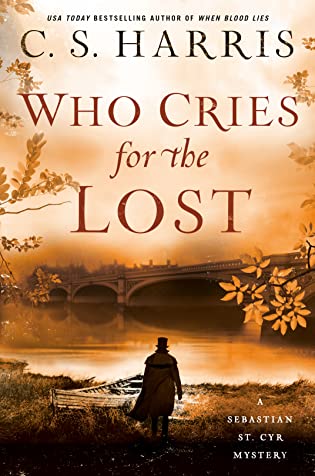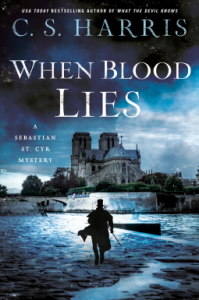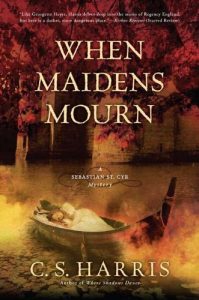 Who Cries for the Lost (Sebastian St. Cyr, #18) by C.S. Harris
Who Cries for the Lost (Sebastian St. Cyr, #18) by C.S. Harris Format: eARC
Source: supplied by publisher via Edelweiss
Formats available: hardcover, ebook, audiobook
Genres: historical fiction, historical mystery, mystery
Series: Sebastian St. Cyr #18
Pages: 352
Published by Berkley on April 18, 2023
Purchasing Info: Author's Website, Publisher's Website, Amazon, Barnes & Noble, Kobo, Bookshop.org, Better World Books
Goodreads
June 1815. The people of London wait, breathlessly, for news as Napoleon and the forces united against him hurtle toward their final reckoning at Waterloo. Among them is Sebastian St. Cyr, Viscount Devlin, frustrated to find himself sidelined while recovering from a dangerous wound he recently received in Paris. When the mutilated corpse of Major Miles Sedgewick surfaces from the murky waters of the Thames, Sebastian is drawn into the investigation of a murder that threatens one of his oldest and dearest friends, Irish surgeon Paul Gibson.
Gibson’s lover, Alexi Sauvage, was tricked into a bigamous marriage with the victim. But there are other women who may have wanted the cruel, faithless Major dead. His mistress, his neglected wife, and their young governess who he seduced all make for compelling suspects. Even more interesting to Sebastian is one of Sedgewick’s fellow officers, a man who shared Sedgewick’s macabre interest in both old English folklore and the occult. And then there’s a valuable list of Londoners who once spied for Napoleon that Sedgewick was said to be transporting to Charles, Lord Jarvis, the Regent’s powerful cousin who also happens to be Sebastian’s own father-in-law.
The deeper Sebastian delves into Sedgewick’s life, the more he learns about the Major’s many secrets and the list of people who could have wanted him dead grows even longer. Soon others connected to Sedgewick begin to die strange, brutal deaths and more evidence emerges that links Alexi to the crimes. Certain that Gibson will be implicated alongside his lover, Sebastian finds himself in a desperate race against time to stop the killings and save his friends from the terror of the gallows.
My Review:
I had always planned to read this book. At this point there are a few books in the middle of the series I haven’t read, but St. Cyr is such a comfort read for me that I’ll be filling in those gaps whenever I need a reading pick-me-up filled with the perfect blend of history and mystery.
But last week I was bouncing hard off of every book I started, and I remembered that this was coming out soon and was guaranteed to solve my inability to settle on a good book with book I knew would be compelling and instantly absorbing.
And so it proved.
Sebastian St. Cyr, Viscount Devlin, is a fascinating character because of his inability to stop poking his aristocratic nose into situations that the majority of the people in what should be his circle would much prefer he didn’t. At least the people who would be if he wasn’t still suffering from what to our minds looks like a roiling boil of PTSD and survivor’s guilt.
 St. Cyr served as a cavalry officer and sometimes an undercover operative in the worst places and days of the Napoleonic Wars. Wars that are not quite over when this entry in the series takes place in June of 1815, barely a season after the events of the previous book in the series, the excellent When Blood Lies.
St. Cyr served as a cavalry officer and sometimes an undercover operative in the worst places and days of the Napoleonic Wars. Wars that are not quite over when this entry in the series takes place in June of 1815, barely a season after the events of the previous book in the series, the excellent When Blood Lies.
The timing of this story is significant, both in the wider world and in St. Cyr’s personal timeline. He is still recovering from a severe injury that occurred in that previous book, an injury that he is pushing himself much too hard to recover from.
Not just because he’s that kind of person, but because he’s more than politically astute enough to know that the inevitable result of Napoleon’s escape from Elba on March 1 means that a battle between whatever forces Napoleon can raise and the English forces on the continent is inevitable. And that the British high command has their collective heads up their collective arses.
St. Cyr isn’t after glory. He feels like he owes it to the men he served with to see as many of them as possible through the coming battle. But he’s all too aware that he isn’t ready.
The overarching tension of Who Cries for the Lost is all focused on the continent. Communication is NOT instantaneous. The entire country – including its government – is on tenterhooks waiting for news from the battlefields. While the early news is very confused and mostly not good.
But amidst the heightened tensions boiling abroad, agents of the restored Bourbon dynasty, temporarily in exile and hopefully soon to be restored again and propped up by England, and agents of Napoleon’s government are waging a bit of a proxy war – or a last chance to settle old scores – on St. Cyr’s doorstep.
Not literally his, but rather that of his friend Paul Gibson, the anatomist who does autopsies for Scotland Yard.
One of their former comrades-in-arms, one they honestly hoped to never see again, has turned up on Gibson’s autopsy table – without either his head or his hands. Gibson recognizes the man from the scars of wounds that he himself treated in the field. But Gibson’s lover knows the mutilated corpse’s identity even before the autopsy begins.
He used to be her husband. Or at least, he once deceived her into thinking that was so. Which makes her the prime suspect for his murder. After all, she is merely a French émigré, and the late unlamented was a second son of the aristocracy. His brother is determined that this woman who stained his brother’s name (there’s a HUGE hahaha there) pay for the crime, whether she did it or not.
Or course, St. Cyr is not so sure. Not because he believes Alexi Sauvage is incapable of murder, just that the circumstances of this crime are physically beyond her. And the dead man was a complete bounder and everyone who served with him knew it all too well and to their cost.
But if it’s not a crime of passion, then what got Miles Sedgewick killed? And why are so many influential people trying so hard to cover up the crime?
St. Cyr won’t rest until he finds out – because he never does. Especially as the pile of mutilated corpses continues to rise.
Escape Rating A+: This was, absolutely, the right book at the right time. I was all in from the very first page, and didn’t let go until after I turned the very last page. As it should be.
I’m also aware that I’m writing a LOT about this book. Which is, quite honestly, part of the charm of the whole damn series. There is always a LOT going on in each book, and it’s always on more than one level. Hence the compulsion once I start one to pretty much barrel right through until the end.
So every book in the series, at this point at least, has two threads that dovetail into each other. On one level, there’s a murder. The stories usually kick off (pun intended) with the discovery of a corpse. There’s a detective, St. Cyr, often with the assistance of his wife Hero and the anatomist Paul Gibson, as well as Sir Henry Lovejoy, currently the most active governor of Scotland Yard, and even his legal father the Earl of Hendon (there’s a story behind that story as well). All too frequently there’s the general and sometimes specific opposition of Sir Henry Jarvis, the power behind the Prince Regent’s regency AND St. Cyr’s father in law.
From a certain perspective, St. Cyr is Sherlock Holmes nearly a century early and Jarvis is a version of Mycroft that bears rather a sharp resemblance to the extremely manipulative and sociopathic version of the character that Mary Russell is on the outs with in the Russell/Holmes series by Laurie R. King.
St. Cyr’s investigations are always complex and convoluted, because the crimes that he involves himself with seem to inevitably stretch into the halls of power in one way or another. His investigations frequently make the powerful uncomfortable because he is an insider who should be on their side – but is absolutely not.
Mixed in with the usual sort of mystery that opens each book are the history and politics of the period. That’s been especially apparent in this book and the previous as all the events of the story are woven with significant historical events, in the case of this book, the tension in England as everyone waits for news of the battle that will go down in history as Waterloo.
A battle whose outcome seems predetermined as we view it with 20/20 hindsight, but was far from as certain in the days leading up to it. Napoleon WAS a tactical genius, while Wellington was far too busy attending balls and chasing his officers’ wives to give the matter the attention it was due – and entirely too many people knew that.
 What kept this reader going through the story was the skill with which the two threads were woven together. Was Sedgewick killed for his many, many misdeeds? Or was he killed to stop, or conceal, treason or espionage? Or was it purely revenge? Or all of the above? Getting that question answered while exploring St. Cyr’s world made for a compelling read. As it has every single time since What Angels Fear in 2005 (or 1811 from St. Cyr’s perspective.)
What kept this reader going through the story was the skill with which the two threads were woven together. Was Sedgewick killed for his many, many misdeeds? Or was he killed to stop, or conceal, treason or espionage? Or was it purely revenge? Or all of the above? Getting that question answered while exploring St. Cyr’s world made for a compelling read. As it has every single time since What Angels Fear in 2005 (or 1811 from St. Cyr’s perspective.)
Thankfully, this series feels far from over. So I have high hopes of seeing St. Cyr’s next adventure sometime next spring. In the meantime, I’ll continue to investigate the few books in the series I missed along the way. Next time I’m looking for a reading pick-me-up I’ll be diving into When Maidens Mourn.



















